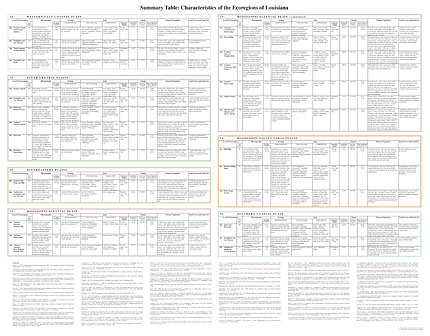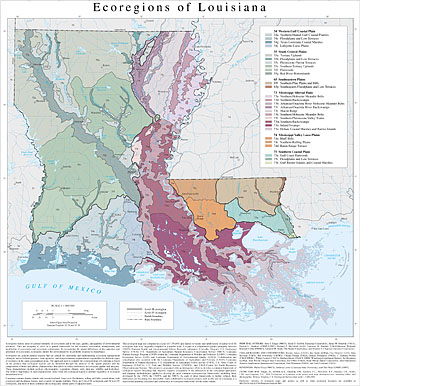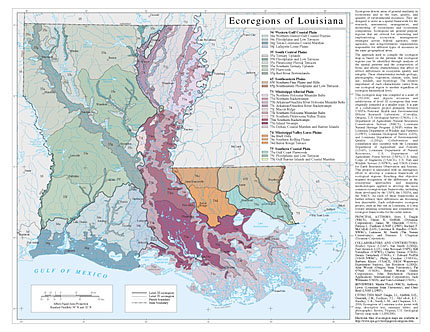The approach used to compile this map is based on the premise that ecological regions can be identified through the analysis of the spatial patterns and the composition of biotic and abiotic phenomena that affect or reflect differences in ecosystem quality and integrity (Wiken, 1986; Omernik, 1987, 1995). These phenomena include geology, physiography, vegetation, climate, soils, land use, wildlife, and hydrology. The relative importance of each characteristic varies from one ecological region to another regardless of the hierarchical level. A Roman numeral hierarchical scheme has been adopted for different levels of ecological regions. Level I is the coarsest level, dividing North America into 15 ecological regions. Level II divides the continent into 52 regions (Commission for Environmental Cooperation Working Group, 1997). At level III, the continental United States contains 104 ecoregions and the conterminous United States has 84 ecoregions (United States Environmental Protection Agency [USEPA], 2003). Level IV is a further subdivision of level III ecoregions. Explanations of the methods used to define the USEPA’s ecoregions are given in Omernik (1995), Omernik and others (2000), Griffith and others (1994), and Gallant and others (1989). The approach used to compile the ecoregion map of Louisiana is based on the premise that ecological regions can be identified through the analysis of the spatial patterns and the composition of biotic and abiotic characteristics that affect or reflect differences in ecosystem quality and integrity (Wiken, 1986; Omernik, 1987, 1995). These characteristics include geology, physiography, vegetation, climate, soils, land use, wildlife, and hydrology. The relative importance of each characteristic varies from one ecological region to another regardless of ecoregion hierarchical level. Louisiana contains barrier islands and coastal lowlands, large river floodplains, rolling and hilly coastal plains with evergreen and deciduous forests, and a variety of aquatic habitats. There are 6 level III ecoregions and 28 level IV ecoregions, and most of these continue into ecologically similar parts of adjacent states (Chapman and others, 2004; Griffith and others, 2004; Woods and others, 2004). The ecoregion map on this poster was compiled at a scale of 1:250,000, and depicts revisions and subdivisions of earlier level III ecoregions that were originally compiled at a smaller scale (U.S. Environmental Protection Agency, 2006; Omernik, 1987). It is part of a collaborative project primarily between USEPA–National Health and Environmental Effects Research Laboratory (Corvallis, Oregon), U.S. Geological Survey (USGS), U.S. Department of Agriculture–Natural Resources Conservation Service (NRCS), Louisiana Natural Heritage Program (LNHP) within the Louisiana Department of Wildlife and Fisheries (LDWF), Louisiana Geological Survey (LGS), and Louisiana Department of Environmental Quality (LDEQ). Collaboration and consultation also occurred with the Louisiana Department of Agriculture and Forestry (LDAF), Louisiana Department of Natural Resources, U.S. Department of Agriculture–Forest Service (USFS), U.S. Army Corps of Engineers (USACE), U.S. Fish and Wildlife Service (USFWS), and USGS–Center for Earth Resources Observation and Science. This project is associated with an interagency effort to develop a common framework of ecological regions (McMahon and others, 2001). Reaching that objective requires recognition of the differences in the conceptual approaches and mapping methodologies applied to develop the most common ecoregion-type frameworks, including those developed by the USFS (Bailey and others, 1994), the USEPA (Omernik 1987, 1995), and the U.S. Department of Agriculture–Soil Conservation Service (1981). As each of these frameworks is further refined, their differences are becoming less discernible. Each collaborative ecoregion project, such as this one in Louisiana, is a step toward attaining consensus and consistency in ecoregion frameworks for the entire nation. Bailey, R.G., Avers, P.E., King, T., and McNab, W.H., editors, 1994, Ecoregions and subregions of the United States (map): Washington, D.C., U.S. Department of Agriculture–Forest Service, map scale 1:7,500,000. Bryce, S.A., Omernik, J.M., and Larsen, D.P., 1999, Ecoregions – a geographic framework to guide risk characterization and ecosystem management: Environmental Practice, v. 1, no. 3, p. 141-155. Chapman, S.S., Griffith, G.E., Omernik, J.M., Comstock, J.A., Beiser, M.C., and Johnson, D., 2004, Ecoregions of Mississippi (2 sided color poster with map, descriptive text, summary tables, and photographs): Reston, Virginia, U.S. Geological Survey, map scale 1:1,000,000. Chapman, S.S., Kleiss, B.A., Omernik, J.M., Foti, T.L., and Murray, E.O., 2004, Ecoregions of the Mississippi Alluvial Plain (color poster with map, descriptive text, summary tables, and photographs): Reston, Virginia, U.S. Geological Survey, map scale 1:1,150,000. Commission for Environmental Cooperation Working Group, 1997, Ecological regions of North America – toward a common perspective: Montreal, Commission for Environmental Cooperation, 71 p. Gallant, A.L., Whittier, T.R., Larsen, D.P., Omernik, J.M., and Hughes, R.M., 1989, Regionalization as a tool for managing environmental resources: Corvallis, Oregon, U.S. Environmental Protection Agency, EPA/600/3-89/060, 152 p. Griffith, G.E., Bryce, S.A., Omernik, J.M., Comstock, J.A., Rogers, A.C., Harrison, B., Greenwade, J., Casby-Horton, S., Hatch, S.L., and Bezanson, D., 2004, Ecoregions of Texas (color poster with map, descriptive text, and photographs): Reston, Virginia, U.S. Geological Survey, map scale 1:2,500,000. McMahon, G., Gregonis, S.M., Waltman, S.W., Omernik, J.M., Thorson, T.D., Freeouf, J.A., Rorick, A.H., and Keys, J.E., 2001, Developing a spatial framework of common ecological regions for the conterminous United States: Environmental Management, v. 28, no. 3, p. 293-316. Omernik, J.M., 1987, Ecoregions of the conterminous United States (map supplement): Annals of the Association of American Geographers, v. 77, p. 118-125, map scale 1:7,500,000. Omernik, J.M., 1995, Ecoregions – a framework for environmental management, in Davis, W.S., and Simon, T.P., editors, Biological assessment and criteria – tools for water resource planning and decision making: Boca Raton, Florida, Lewis Publishers, p. 49-62. Omernik, J.M., 2004, Perspectives on the nature and definition of ecological regions: Environmental Management, v. 34, Supplement 1, p. s27-s38. Omernik, J.M., Chapman, S.S., Lillie, R.A., and Dumke, R.T., 2000, Ecoregions of Wisconsin: Transactions of the Wisconsin Academy of Sciences, Arts, and Letters, v. 88, p. 77-103. U.S. Department of Agriculture–Soil Conservation Service, 1981, Land resource regions and major land resource areas of the United States: Agriculture Handbook 296, 156 p. + map. U.S. Environmental Protection Agency, 2006, Level III ecoregions of the continental United States (revision of Omernik, 1987): Corvallis, Oregon, USEPA–National Health and Environmental Effects Research Laboratory, Map M-1, various scales. Wiken, E., 1986, Terrestrial ecozones of Canada: Ottawa, Environment Canada, Ecological Land Classification Series no. 19, 26 p. Woods, A.J., Foti, T.L., Chapman, S.S., Omernik, J.M., Wise, J.A., Murray, E.O., Prior, W.L., Pagan, J.B., Jr., Comstock, J.A., and Radford, M., 2004, Ecoregions of Arkansas (color poster with map, descriptive text, summary tables, and photographs): Reston, Virginia, U.S. Geological Survey, map scale 1:1,000,000. PRINCIPAL AUTHORS: Jerry J. Daigle (NRCS), Glenn E. Griffith (Dynamac Corporation), James M. Omernik (USGS), Patricia L. Faulkner (LNHP-LDWF), Richard P. McCulloh (LGS), Lawrence R. Handley (USGS-National Wetlands Research Center [NWRC]), Latimore M. Smith (The Nature Conservancy), and Shannen S. Chapman (Dynamac Corporation). COLLABORATORS AND CONTRIBUTORS: Bradley Spicer (LDAF), Sue Smith (LDEQ), Paul Heinrich (LGS), John Novosad (USFS), Bill Vermillion (USFWS), Charles Demas (USGS), Dennis Demcheck (USGS), C. Edward Proffitt (USGS-NWRC), Philip Crocker (USEPA), Barbara Kleiss (USACE, ERDC-Waterways Experiment Station), Jan Boydston (LDEQ), Alan Woods (Oregon State University), Pat O'Neil (USGS), Brian Moran (Indus Corporation), John Hutchinson (Science Applications International Corporation), Jack Wittmann (USGS), and Tom Loveland (USGS).
Ecoregion Links |



